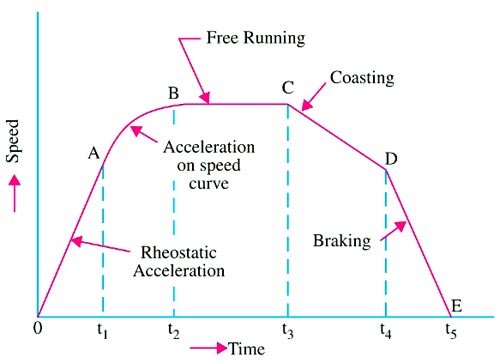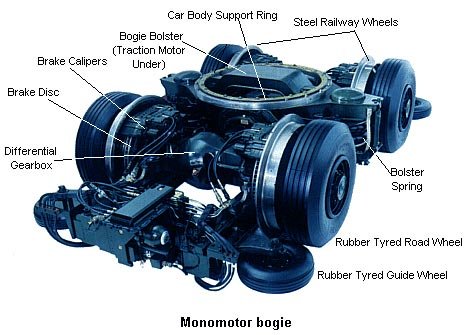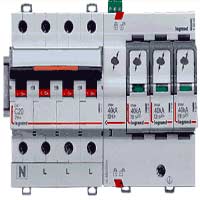Ques.31. The curve that shows the instantaneous speed of the train in kmph along the ordinate and time in seconds along the abscissa is known
- Speed – Distance curve
- Distance- Time curve
- Power-speed curve
- Speed- time curve
Answer.4. Speed- time curve Explanation:- The movement of trains and their energy consumption is most conveniently studied by means of speed-time and speed-distance curves, which show respectively the speed at various times after the start of the run and the speed at various distances from the starting point. The curve that shows the instantaneous speed of the train in kmph along the ordinate and time in seconds along the abscissa is known as the speed-time curve. The area under the speed time curve gives the distance traveled during, given time internally and slope at any point on the curve toward abscissa gives the acceleration and retardation at the instance, out of the two speed—time curve is more important.
Ques.32. The curve that shows the distance between two stations in km along the ordinate and time in seconds along the abscissa is known as the
- Speed – Distance curve
- Distance- Time curve
- Power-speed curve
- Speed- time curve
Answer.1. Speed- Distance curve Explanation:- The curve that shows the distance between two stations in km along the ordinate and time in seconds along the abscissa is known as the speed-distance curve.
Ques.33. If the coefficient of adhesion on dry rails 0.25. which of the following could be the value for wet rails?
- 0.32
- 0.25
- 0.245
- 0.15
Answer.4. 0.15 Explanation:- Adhesive weight:- The total weight to be carried out on the drive in wheels of a locomotive is known as adhesive weight. Coefficient of adhesion:- It is deemed as the ratio of the tractive effort required to propel the wheel of a locomotive to its adhesive weight µ = Ft/W Where Ft = Tractive effort W = Adhesive Weight The coefficient of adhesion may be viewed as the coefficient of friction between the tyre of a wheel at rest and the rail. If the diameters of all the wheels were exactly the same, then the conditions of adhesion would also be the same regardless of whether the locomotive was at rest or moving. But in practice, there are always some very small differences between the wheel diameters and therefore, the wheels cannot turn on the track all at the same speed and without a certain amount of slipping. Since even the smallest amount of slipping reduces the coefficient of friction, the value of adhesion must also decrease. The magnitude of adhesion depends on the material used for making the wheel tyres and rails as well as on the state of both the wheel tyres and the rails. In traction calculations, the coefficient e is usually obtained from tables assembled from experimental data So according to the above table if the value of Dry rail is 0.25 then the value of Wet Rail is dry rails 0.05 − 0.15
No
State of Rail
µ Value of Steel
µ Value of Cast Iron
1
Rail Dry with sanding
0.30 − 0.33
0.25
2
Rail Dry without sanding
0.25
0.25
3
Rail Moist
0.20
0.15
4
Rail Wet
0.05 − 0.15
0.05 − 0.10
Ques.34. Specific energy consumption is least in
- Urban service
- Sub-urban service
- Mainline service
- Equal for all types of services
Answer.3. Mainline service Explanation:- The energy input to the motors is called the energy consumption. This is the energy consumed by various parts of the train for its propulsion. The energy drawn from the distribution system should be equals to the energy consumed by the various parts of the train and the quantity of the energy required for lighting, heating, control, and braking. This quantity of energy consumed by the various parts of train per ton per kilometer is known as specific energy consumption. It is expressed in watt-hours per ton per km. Specific energy consumption = Total energy consumed in Wh ⁄ train mass in tonne × run length in km The specific energy consumption is inversely proportional to the distance between stations. Greater the distance between stops is, the Iesser will be the specific energy consumption The typical values of the specific energy consumption is less for the mainline service of 20-30 W-hr/ton-km and high for the urban and suburban services of 50-70 W-hr/ton-km.
Ques.35. B0 B0 locomotives have two bogies with
- Four driving axles each with individual driving motors
- Three driving axles with group drives
- Two driving axles with group drives
- Two driving axles with individuals drive motor
Answer.4. Two driving axles with individuals drive motor Explanation:- Roiling Stock Wheel Arrangements The wheelset can be driven when torque is applied, or load-bearing otherwise. Normally rolling stock wheel arrangement layout is identified by an alpha-numeric code indicating the distribution of the wheelsets among the various bogies or partial frames, distinguishing between driven and loadbearing wheelsets. Each group of wheelsets belonging to the same bogie or frame is marked by a letter of the alphabet if the wheelsets are driven, or by a simple number if they are load-bearing: the number or the order of the letter corresponds to the number of adjacent wheelsets few., B corresponds to two wheelsets; C corresponds to three wheelsets. Moreover, the letters without subscripts refer to groups of driven wheelsets mechanically coupled to one another by means of connecting rods or gears, while the zero subscript denotes an individually or independently controlled wheelset, each of which is driven by a motor. Some examples are listed here, classified according to traction vehicle.
Ques.36. Locomotives with monomotor bogie have
- A lot of skidding
- Low coefficient of adhesion
- Uneven distribution of the tractive effect
- Suitability for the passenger as well as freight service
Answer.4. Suitability for the passenger as well as freight service Explanation:- A monomotor is a train design where a single traction motor powers two or three axles in the same bogie. Conventional bogie design involves either having one motor for each axle or having one or more axles unpowered. The monomotor design causes the motor to give both axles the same number of revolutions per minute. The monomotor design makes it relatively easy to fit a locomotive with two-speed gearing. Low gear is used when hauling freight trains and high gear is used when hauling express passenger trains.
Ques.37. The advantages of 25-kV, 50 Hz AC system is
- Less number of substation
- High flexiblity
- High coefficient of adhesion
- All of the above
Answer.4. All of the above Explanation:- Advantages of this system of track electrification over other systems particularly the dc system are as under: Light Overhead Catenary Since the voltage is high (25 kV), line current for a given traction demand is less. Hence, the cross-section of the overhead conductors is reduced. Since these small-sized conductors are light, supporting structures and foundations are also light and simple. Of course, a high voltage needs higher insulation which increases the cost of overhead equipment (OHE) but the reduction in the size of conductors has an overriding effect. Less Number of Substations Since in the 25-kV system, line current is less, the line voltage drop which is mainly due to the resistance of the line is correspondingly less. It improves the voltage regulation of the line which fact makes larger spacing of 50-80 km between sub-stations possible as against 5-15 km with 1500 V dc system and 15-30 km with 3000 V dc system. Since the required number of substations along the track is considerably reduced, it leads to a substantial saving in the capital expenditure on track electrification. Flexibility in the Location of Substations Larger spacing of substations leads to greater flexibility in the selection of the site for their proper location. These substations can be located near the national high-voltage grid which, in our country, fortunately, runs close to the main railway routes. The substations are fed from this grid thereby saving the railway administration lot of expenditure for erecting special transmission lines for their substations. On the other hand, in view of closer spacing of dc substations and their far away location, railway administration has to erect its own transmission lines for taking the feed from the national grid to the substations which consequently increases the initial cost of electrification. Simplicity of Substation Design In ac systems, the substations are simple in design and layout because they do not have to install and maintain rotary converters or rectifiers as in dc systems. They only consist of static transformers along with their associated switchgear and take their power directly from the high-voltage national grid running over the length and breadth of our country. Since such sub-stations are remotely controlled, they have few attending personnel or even may be unattended. Lower Cost of Fixed Installations The cost of fixed installations is much less for 25 kV ac system as compared to the dc system. In fact, the cost is in ascending order for 25 kV ac, 3000 V dc, and 1500 V dc systems. Consequently, traffic densities for which these systems are economical are also in the ascending order. Higher Coefficient of Adhesion The straight dc locomotive has a coefficient of adhesion of about 27% whereas its value for ac rectifier locomotive is nearly 45%. For this reason, a lighter ac locomotive can haul the same load as a heavier straight dc locomotive. Consequently, ac locomotives are capable of achieving higher speeds in coping with heavier traffic. Higher Starting Efficiency An ac locomotive has higher starting efficiency than a straight dc locomotive. In dc locomotive supply voltage at starting is reduced by means of ohmic resistors but by on-load primary or secondary tap-changer in ac locomotives.Advantages of 25-kV, 50-Hz AC System
Ques.38. Which of the following is a self-contained locomotive
- Diesel locomotive
- Steam locomotive
- Battery locomotive
- Any of the above
Answer.4. Any of the above Explanation:- Self-contained locomotives In this type, the locomotives or vehicles themselves having a capability of generating electrical energy for traction purpose. Examples for such type of locomotives are: Steam electric drive In steam electric locomotives, the steam turbine is employed for driving a generator used to feed the electric motors Such types of locomotives are not generally used for traction because of some mechanical difficulties and maintenance problems. Diesel-electric trains A few locomotives employing diesel engine coupled to DC generator used to feed the electric motors producing necessary propelling torque. The diesel engine is a variable high-speed type that feeds the self- or separately excited DC generator The excitation for the generator can be supplied from any auxiliary devices and battery. Generally, this type of traction system is suggested in the areas where coal and steam tractions are not available. Petrol-electric traction This system of traction is used in road vehicles such as heavy lorries and buses. These vehicles are capable of handling overloads. At the same time, this system provides fine and smooth control so that they can run along roads without any jerking. Battery drives In this drive, Ihc locomotive consists of batteries used to supply power to DC motors employed for driving the vehicle This type of drives can be preferred for frequently operated services such as local delivery goods traction in industrial works and mines, etc. This is due to the unreliability of supply source to feed the electric motors.
Ques.39. For tramways circuit the return path is
- Through cables
- Through rails
- Through neutral wire
- Through common earthing
Answer.2. Through rails Explanation:- In electric trains, circuit gets completed through tracks only which work as the return conductor. Overhead wire is on 25 KV( in few cases this voltage is different) with respect to earth or tracks. Similarly our domestic supply of 230 Volts, it is also grounded so phase voltage is 230 w.r.t. earth. If you connect a bulb between phase and earth, the bulb will glow, return current through earth but there will be no electrocution of people present on earth due to that. Because the rails are at ground potential, and one can assume that people are connected to ground potential, there is no or only a neglectable potential difference, and there are no problems. Trams normally take their power from a single, thicker overhead wire, often suspended from a centenary wire, by means of a pantograph fitted to the top of the vehicle. The reason trams only use a single electric contact wire is that they use the running rails for the electrical return to complete the electric circuit to provide the power. Trolleybuses, having no rails, and indeed being insulated by the rubber lyres, need the second overhead wire to provide the electrical return and complete the circuit.
Ques.40. A train has a schedule speed of 36 km per hour on a level track. If the distance between the stations is 2 km and the stoppage is 30 seconds the actual time of run will be
- 260 seconds
- 230 seconds
- 200 seconds
- 170 seconds
Answer.4. 170 seconds Explanation:- Here Distance = 2000 km Speed = 36 km = 36 × 5/18 = 10m/s Time = Distance/Speed = 2000/10 = 200s Actual time = 200 − 30 = 170 second



